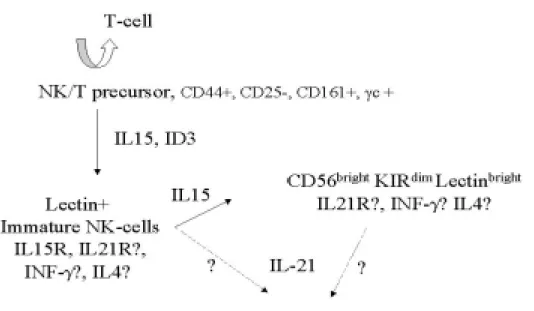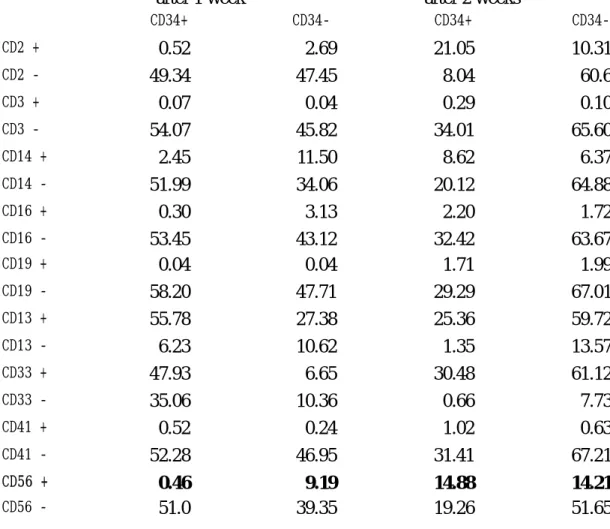行政院國家科學委員會專題研究計畫 期中進度報告
自然弒細胞發生學的雙系模式:白血球介質 15 及 21 分別導
引 CD56+Kir±lectis+ 及 CD56±Kirlectin 自然弒細胞
(2/3)
計畫類別: 個別型計畫 計畫編號: NSC92-2314-B-002-118- 執行期間: 92 年 08 月 01 日至 93 年 07 月 31 日 執行單位: 國立臺灣大學醫學院免疫學研究所 計畫主持人: 許世明 計畫參與人員: 楊朝順、謝嘉珊、王坤謄 報告類型: 精簡報告 報告附件: 出席國際會議研究心得報告及發表論文 處理方式: 本計畫可公開查詢中 華 民 國 93 年 5 月 18 日
行政院國家科學委員會補助專題研究計畫期中進度報告
A dual lineage model for the development of mature human NK-cells.
自然弒細胞發生學的雙系模式:白血球介質 15 及 21 分別導引 CD56
+Kir
+-lectis
+及 CD56
+-Kir lectin 自然弒細胞 (2/3)
計畫類別:▓ 個別型計畫
計畫編號:NSC 92-2314-B-002-118
執行期間:92 年 08 月 01 日至 93 年 07 月 31 日
計畫主持人:許世明
共同主持人: 林中梧
計畫參與人員:
楊朝順、謝嘉珊、王坤謄
成果報告類型(依經費核定清單規定繳交):▓ 精簡報告 □完整報告
本成果報告包括以下應繳交之附件:
□赴國外出差或研習心得報告一份
□赴大陸地區出差或研習心得報告一份
□出席國際學術會議心得報告及發表之論文各一份
本人未出席國際學術會議經費未動支
□國際合作研究計畫國外研究報告書一份
處理方式:除產學合作研究計畫、提升產業技術及人才培育研究計畫、
列管計畫及下列情形者外,得立即公開查詢
□涉及專利或其他智慧財產權,□一年□二年後可公開查詢
執行單位:台大
免疫學研究所
中 華 民 國 93 年 5 月 15 日
附件一中文摘要
自然殺手細胞的雙系發生學模式:
關鍵字:雙系模式、細胞介質 15(IL15)、細胞介質 21(IL21)、白血球
表面抗原 56(CD56)、自然殺手細胞類免疫球蛋白(KIR),糖
類接合蛋白(Lectin),白血球球表面抗原 94(CD94)。
人體周邊血液中有二種主要的自然殺手細胞,分別有顯著不同的表面抗原,
CD56
+KIR
+/-Lectin
+及 CD 56
±KIR
+Lectin
±,本計劃將重細胞發生學的觀點來
澄清這兩種自然殺手細胞的來源。
本計劃至目前為止,已完成下列四項主要目標:
1. 臍帶血 CD34
+幹細胞之分離及擴增
我們已成功將 CD34
+幹細胞由臍帶血分離,在混合白血球介質刺激下,經
培養 1~2 個星期後,可以擴增 5~10 倍。
2. CD56 表現於約 10%的 CD34
-細胞
經過另一組白血球的介質的刺激,我們可以於 10%的 CD34
細胞中發現有
CD56 的表現,這 CD56
+細胞最有可能是 NK 母細胞,但是骨髓胜原始細胞
亦不可能排除,我們將進一步分析之。
3. 鼻咽淋巴癌之系源分析
我們用自然殺手細胞類免疫球蛋白之限制性分布,作有診斷及系源認定的標
準,我們發現,大部份鼻咽淋巴癌源自於自然殺手細胞(Am J Path 2001. 159.
1671)
4.鼻咽淋巴癌之臨床分析
我們更進一步以白血球表面抗原 94(CD94)分析其鼻咽淋巴癌之臨床表現,
發現鼻咽淋巴癌分為 CD94
+及 CD94
-兩種亞型, CD94
+明顯有較佳預後
(Blood 2003. 102. 2623)我們目前正進行比對,以確定這 2 種亞型是否就是
分別由 CD56
+KIR
+/-Lectin
+及 CD 56
±KIR
+Lectin
±這兩種自然殺手細胞演變而
來。
英文摘要
A dual lineage model for the development of mature human NK-cells.
Keywords: dual lineage, IL15, IL21, CD56, KIR, lectin
There are 2 major subtypes of mature NK-cells with differential surface markers in the peripheral blood, CD56+KIR+/-Lectin+ and CD56+/-KIR+Lectin+/-. Our proposal is aimed at clarifying the developmental pathway of these 2 subtypes of mature NK-cells. So far, we have achieved the following:
I: Isolation and expansion of CD34+ stem cells from umbilical cord blood
We have isolated CD34+ stem cells from umbilical cord. We are able to expand the CD34+Lin-
stem cells with the use of an in vitro culture system under cytokine stimulation. An 5-10 fold expansion is achieved after 1-week culture.
II: Partial Induction of CD56 expression, suggestive of NK-differentiation
The expanded stem cells were further grown for another 1 week, to induce differentiation.
Although most cells developed into the myeloid lineage, about 5-10% were CD56+, suggestive of an NK-lineage. To continue the investigation, we are currently using IL-15 to stimulate
proliferation and induction of mature NK-cells.
III: Confirmation of lineage assignment of sinonasal lymphoma
We have performed an extensive assessment of the lineage assignment of sinonasal
lymphomas. We found most sinonasal lymphomas had a restricted killer immunoglobulin-like receptor repertoire, consistent with a NK-lineage. But some cases had a monoclonal T-cell receptor rearrangement plus a restricted killer immunoglobulin-like receptor repertoire, consistent with a mixed NK/T cell lineage. (Am J Path, 2001, 159, 1671.)
IV: Clinical correlation and significance.
Further analysis of the expression pattern of CD94 (the killer lectin-like receptor) showed
that a subset of sinonasal lymphoma had CD94 expression. The CD94 positive subset had a much better prognosis than the CD94-negative subset. (Blood, 2003, 102, 2623) We are currently
investigating whether these 2 subsets correspond to the 2 major subsets of mature NK-cells of the peripheral blood.
報告內容
We have proposed a dual lineage model for NK-cell development.
In the past 2 years, we have tried to evaluate this model from both the developmental biological perspective and from the clinical perspective.
1) the developmental approach: Isolation and expansion of CD34+ stem cells from umbilical cord blood
We have set up a culture system for the isolation and expansion of CD34+Lin- stem cells A representative result is shown below. We usually had 5-10 fold expansion of the stem cells.
Table 1 ex vivo expansion of human CD34+Lin- cells after cytokine stimulation
population before culture 1 week after culture (expansion fold) 2 weeks after culture(expansion fold) Total cells 9×104 1.42×106 (15.7) 4.24×106 (47.1)
CD34+ cells 8.4×104 4.54×105 (5.44) 3.07×105 (3.68)
Fresh CD34+Lin- cells were cultured in IMDM supplemented with 8% human serum, 10 ng/ml SCF, 10 ng/ml IL3, 100 ng/ml IL6, 1000 ng/ml IL6-R, 100ng/ml FLT3, and 20ng/ml TPO.
2) the developmental approach: Partial Induction of CD56 expression, suggestive of NK-differentiation
The expanded stem cells were further grown for another 1 week, to induce differentiation.
Although most cells developed into the myeloid lineage, about 5-10% were CD56+, suggestive of an NK-lineage. To continue the investigation, we are currently using IL-15 to stimulate
proliferation and induction of mature NK-cells.
Table 2 Loss of CD34 and induction of lineage markers
after 1 week after 2 weeks
CD34+ CD34- CD34+ CD34-CD2 + 0.52 2.69 21.05 10.31 CD2 - 49.34 47.45 8.04 60.6 CD3 + 0.07 0.04 0.29 0.10 CD3 - 54.07 45.82 34.01 65.60 CD14 + 2.45 11.50 8.62 6.37 CD14 - 51.99 34.06 20.12 64.88 CD16 + 0.30 3.13 2.20 1.72 CD16 - 53.45 43.12 32.42 63.67 CD19 + 0.04 0.04 1.71 1.99 CD19 - 58.20 47.71 29.29 67.01 CD13 + 55.78 27.38 25.36 59.72 CD13 - 6.23 10.62 1.35 13.57 CD33 + 47.93 6.65 30.48 61.12 CD33 - 35.06 10.36 0.66 7.73 CD41 + 0.52 0.24 1.02 0.63 CD41 - 52.28 46.95 31.41 67.21 CD56 + 0.46 9.19 14.88 14.21 CD56 - 51.0 39.35 19.26 51.65
3)
the clinical approach: Killer immunoglobulin-like receptor repertoire analysisWe have used analysis of the killer immunoglobulin-like receptor repertoire to prove that a subset of sinonasal lymphomas belong to the NK-lineage. We have performed an extensive assessment of the lineage assignment of sinonasal lymphomas. We found most sinonasal lymphomas had a restricted killer immunoglobulin-like receptor repertoire, consistent with a NK-lineage. But some cases had a monoclonal T-cell receptor rearrangement plus a restricted killer immunoglobulin-like receptor repertoire, consistent with a mixed NK/T cell lineage. (Am J
Path, 2001, 159, 1671.)
4) the clinical approach: CD94 expression.
Further analysis of the expression pattern of CD94 (the killer lectin-like receptor) showed that a subset of sinonasal lymphoma had CD94 expression. The CD94 positive subset had a much better prognosis than the CD94-negative subset. (Blood, 2003, 102, 2623-2631) We are
currently investigating whether these 2 subsets correspond to the 2 major subsets of mature NK-cells of the peripheral blood.
參考文獻(Reference)
Models of NK-cell development
Barten R, Torkar M, et al. Divergent and convergent evolution of NK-cell receptors. Trends Immunology, 2001, 22, 52-57.
Loza, MJ, Perussia B. Final steps of natural killer cell maturation: a model for type 1-type 2 differentiation? Nature Immunology, 2001, 10, 917-924.
Parrish-Novak J, Dillion SR, et al. Interleukin 21 and its receptor are involved in NK cell expansion and regulation of lymphocyte function. Nature, 2000, 408, 57-63.
Cooper, MA, Fehniger TA, Caligiuri MA. The biology of human natural killer cell subsets (Review). Trends Immunology, 2001, 22, 623-640.
Fehnigewr TA, Caliguiri MA. Interleukin 15: Biology and relevance to human disease (Review). Blood, 2001, 97, 14-32.
NK and T-cell development
Spits H, Lanier LL, Phillips JH: Development of human T and natural killer cells. Blood 1995, 85:2654-2670.
Carlyle JR, Michie AM, Furlonger C, Nakano T, Lenardo MJ, Paige CJ, and Zúñiga-Pflücker JC. Identification of a novel developmental stage marking lineage commitment of progenitor thymocytes. J Exp Med, 1997, 186:173-182.
Mingari MC, Vitale C, Cantoni C, Bellomo R, Ponte M, Schiavetti F, Bertone S, Moretta L: Interleukin-15 induced maturation of human natural killer cells from early thymic precursors: selective expression of CD94/NKG2-A as the only HLA class I-specific inhibitory receptor. Eur J Immunol 1997, 27:1374-1380.
Yu H, Feniger TA, et al. Flts3 ligand promotes the generation of a distinct CD34+ human natural killer cell progenitor that respond to interleukin 15. Blood, 1998, 92, 3647-3657.
Parrish J, Dillion SR, et al. Interleukin 21 and its receptor are involved in NK cell expansion and regulation of lymphocyte function. Nature, 2000, 408, 57-63.
Ozaki K, Kikly K, et al. Cloning of as type I cytokine receptor most related to the IL-2 receptor
β chain. Proc Natl Aca Sci, 2000, 97, 21, 11439-11444.
Liu CC, Perussia B, Young JDE. The emerging role of IL-15 in NK-cell development. Trends Immunology, 2000, 21, 113-116.
Fehniger TA, Caliguiri MA. Interleukin 15: biology and relevance to human disease. Blood, 2001, 97, 14-32.
Cooper M, Fehninger TA, Caligiuri M. The biology of human natural killer-cell subsets. Trends Immunology, 2001, 22, 633-640.
Phillips JH, Hori T, Nagler A, Bhat H, Spits H, Lanier LL: Ontogeny of human natural killer cells: Fetal NK cells mediate cytolytic function and express cytoplasmic CD3ε, δ proteins. J Exp Med 1982, 175:1055-1066.
Lanier LL, Chang C, Spits H, Phillips JH: Expression of cytoplasmic CD3ε proteins in activated human adult NK cells and CD3γ,δ,ε complexes in fetal NK cells: Implications for the relationship of NK and T lymphocytes. J Immunol 1992, 14:1876-1880.
Suzumiya J, Takeshita M, Kimura N, Kikuchi M, Uchida T, Hisano S, Eura Y, Kozuru M, Nomura Y, Tomita K, Komiyama S, Okumura M: Expression of adult and fetal natural killer cell markers in sinonasal lymphomas. Blood 1994, 83:2255-2260.
Killer cell antigen receptor
Moretta A, Botino C, Vitale M, Pende D, Biassoni R, Mingari MC, and Moretta L: Receptors for HLA class I molecules in human natural killer cells. Annu Rev Immunol 1996, 14:619-648. Wilson MJ, Torkar M, Trowsdale J. Genomic organization of a human killer cell inhibitory
receptor gene. Tissue Antigens.1997;49:574-579.
Steffens U, Vyas Y, Dupont B, et al. Nucleotide and amino acid sequence alignment for human killer cell inhibitory receptors (KIR), 1998. Tissue Antigens.1998;51:386-413.
Long EO and Rajagopalan S: HLA class I recognition by killer cell Ig-like receptors. Semin Immunol 2000, 12:101-108.
Raulet DH: Development and tolerance of natural killer cells. Curr Opini Immunol 2000, 11:129-134.
Raulet DH, Vance RE, McMahon CW. Regulation of the natural killer cell receptor repertoire. Annu Rev Immunol. 2001;19:291-330.
計畫成果自評
請就研究內容與原計畫相符程度、達成預期目標情況
4. 執行進度
子 計 畫 名 稱 Classification of sinonasal lymphoma 第 1 年 (91 年 8 月∼92 年 7 月) 第 2 年 (92 年 8 月∼93 年 7 月) 第 3 年 (93 年 8 月∼__年__月) 季 次 工 作 項 目 第 一 季 第 二 季 第 三 季 第 四 季 第 一 季 第 二 季 第 三 季 第 四 季 第 一 季 第 二 季 第 三 季 第 四 季 Collection of cases x x x x x imunophenotyping x x x x x x x Genotyping, KIR RT-PCR x x x x x Genotyping, TCR PCR x x x x x x
CD34 stem cell isolation x x x x x x
CD34 stem cell expansion x x x x x x
Sorting by paramagnetic beads x x x x x x x
Phenotypical analysis x x x x x x x
Cell sorting, flow cytometry x x x x
Stimulation and inhibition by cytokines IL15
x x x x x
Stimulation and inhibition by cytokines IL21
x x x x
Cellular cytokine analysis x x x x x
Data integration x x x x x
預定進度累計百分比 10 20 30 40 45 50 55 60 70 80 90 100
In summary, we have performed
I: Isolation and expansion of CD34+ stem cells from umbilical cord blood II: Partial Induction of CD56 expression, suggestive of NK-differentiation III: Confirmation of lineage assignment of sinonasal lymphoma
IV: Clinical correlation and significance.
We are currently using IL15 to stimulate proliferation and induction of mature NK-cells, and to see if the 2 subsets of mature NK cells correspond to the 2 clinical subtypes of sinonasal lymphomas.
研究成果之學術或應用價值、是否適合在學術期刊發表或申請專利、主要發現或其他有關 價值等,作一綜合評估
We will submit a manuscript as soon as the project is finished.

